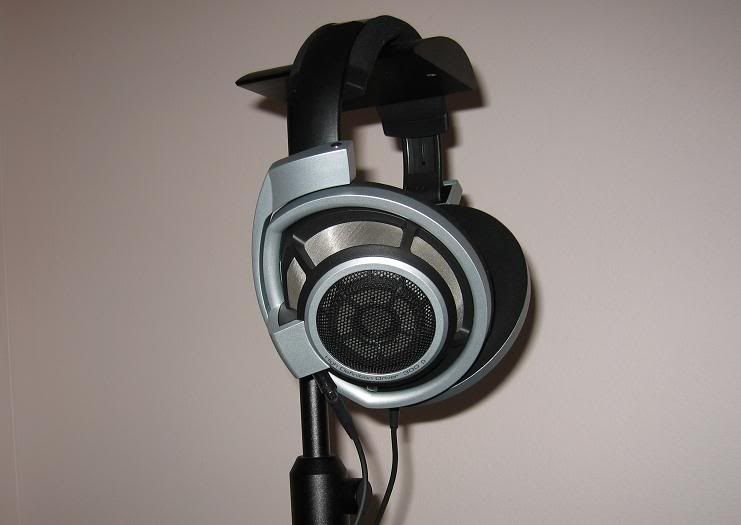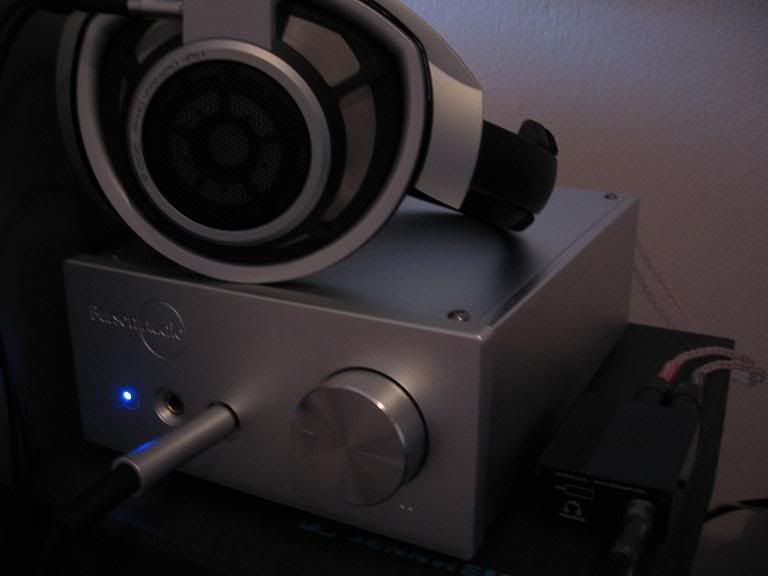Burson Soloist Review
Introduction
As any of the Sydney Head-Fi crew could tell you, I'm obsessed with tone. If a system gets tone right, I'm prepared to forgive quite a few shortcomings in other areas. If a system gets tone wrong, it doesn't matter how fast, resolving, spacious or engaging it sounds; I won't like it long term.Considering that my budget for audio equipment has never been vast (I try to keep each component under the 1 kilobuck ceiling), I've usually had to pick gear that compromised in one or two areas in order to maintain that all-critical natural tone.
As such the Burson HA-160D has lived in my audio rack for over a year now. Like all Burson equipment it is voiced in a very natural way, and provides a great deal of heft, weight and realism whilst sacrificing very little in return (my full review can be read here: http://www.head-fi.org/products/burson-audio-ha-160d/reviews/5532).
About a month ago, Burson sent me an email about a new amplifier they'd designed: the Soloist. They touted it as the successor to the HA-160 "classic" line, a statement product that should close the gap between themselves and their competition. Needless to say, I was keen to give it a try.
Packaging and Build Quality
The first Soloist unit I received was actually dead on arrival; it wouldn't power on. The fuse wasn't blown, and there was no visible damage to the case, so I was at a loss as to the cause. Burson support responded in a timely manner and organized a courier pickup for the faulty unit and shipped me out a replacement.The second unit took packaging to a new level; It was covered with clear plastic wrapping, underneath which was two layers of bubble wrap, underneath which was the cardboard box. Within that was the "normal" fitted styrofoam, cloth wrap and silica gel pack I've come to expect from Burson. It'd take a pretty evil postie to damage the unit this time around!
As a standalone amplifier, connectivity and usability has been greatly improved since the HA-160 days; three selectable RCA inputs, one headphone jack and 3 gain settings. Those who like to connect multiple headphones so friends can listen in won't like the single jack (Wink, I'm looking at you!), but for most single-user headphone recluses like me it won't be an issue.
The aluminium casing on the Soloist has changed slightly from the HA-160D; it looks like a combination of sandblasted and then brushed, giving a slightly more "powdery" look. Fingerprints and dust don't show up quite as readily as a result, which suits me just fine.
On popping the lid on the Soloist, I was greeted with a beautifully clean internal layout. I'm no engineer, but the board is very visually appealing at least. Burson seem to have gone for a completely encapsulated toroid this time as well, rather than the shielded versions they've used previously.
Review Setup
For this review I have compared the amplifier section of the HA-160D against the Soloist, in the following setup:Laptop as source (Foobar with WASAPI for music playback, FLAC lossless files) > USB input to the HA-160D (volume attenuator set to 12 oclock) > preamp outputs to the Soloist's RCA inputs (volume attenuator set to 11 oclock), medium gain selected > LCD-2 rev1 headphones.
The low gain jack on the HA-160D seems volume-matched to the jack on the Soloist in this configuration, allowing me to quickly switch between amplifiers.
The Soloist was burned in for approximately 15 hours (the HA-160D has over 100 hours), and all equipment was allowed one hour to warm up prior to listening.
Listening Impressions: Casual
After a year of owning the HA-160D I'm very familiar with its sound signature. So the last week was spent listening to the Soloist exclusively for enjoyment, without any critical listening. This allows me to get familiar with the Soloist's overall presentation and character before I start nit-picking at fine details.My overall impression was one of both musicality and refinement. Two poetic words that often get bandied about in audiophile reviews, but in a nutshell those were my thoughts. The Soloist takes the classic Burson strengths (tone, texture, immediacy) and adds a very liberal dose of technical accomplishment.
Even in casual listening I was detecting much greater instrument separation, creating a few 'eargasmic' moments (if that's not a word, it should be) as details were revealed in recordings that had been masked previously.
The time I spent listening to the Soloist seemed less fatiguing than normal. There was an ease to the Soloist that hadn't been present on the HA-160D, allowing me to listen longer and enjoy my music more.
Listening Impressions: Critical
Following the week of casual listening I spent a day of critical listening, where I performed A/B comparisons of both amps with short sections of reference music.Test Track #1: Angus and Julia Stone - For You
Angus and Julia Stone are among my favourite artists at the moment, and I've listened to their 'Down the Way' album obsessively over the past year. Not only does this track sound magical with Julia's very clear and forward vocals, it also really tests a system's ability to image accurately.
Julia's vocal in this track is positioned in the front-left of the soundfield, around about 11 O'Clock. So some ability to portray depth is required to position her vocal correctly. Furthermore there are layers of acoustic guitar in the front and extreme left and right of the soundfield, which often tend to get obscured by the dominant vocal in the mid-left.
The HA-160D struggled to image Julia's voice correctly. Her voice had a tendency to waver too far to the left, creating an unpleasant mono-sound that impacted on the realism of the portrayal. Guitar chords on the extreme ends of the soundfield were also muffled slightly, becoming indistinct and part of a background "wall of sound".
In contrast, the Soloist displayed much better depth portrayal with Julia's voice. She remained very firmly mid-left, her voice resonating naturally across the soundfield. Guitar chords remained distinct, even as Julia unleashed those glorious vocals. Easy win for the Soloist on this round.
Test Track #2: Bruce Mathiske - 23 Hours in Geneva
For the non-aussies out there, if you're into acoustic guitar you should check out Bruce Mathiske. This track in particular is very vibrant, with layers of long-decaying guitar notes reverberating throughout the soundfield. This provides a great tone and timbre test, showcasing whether a system can re-create natural decay and harmonics well.
On this track the Soloist and HA-160D were much closer in performance, requiring numerous A/B comparisons to detect a difference. My initial impression was that the Soloist was somehow easier to listen to and more engaging, but the "why" of that impression was much more difficult to ascertain. Leading edges have similar levels of bite and shimmer, decay lengths were about the same, and neither seemed more forward than the other.
Eventually I figured out the key difference resided in the domain of depth portrayal again. The Soloist was providing a deeper, more 3-dimensional soundstage for notes to reverberate within. The HA-160D in comparison was flatter, creating a less natural ambiance that was ultimately less enjoyable and more fatiguing to listen to. A narrower win for the Soloist this round.
Test track #3: Infected Mushroom - I'm the Supervisor
I have weird and eclectic musical tastes, I know. Infected Mushroom routinely make well-recorded and extremely dynamic albums, and this is no exception. The cover track in particular has a very localized, thumping drum hit in the centre of the soundstage that makes for an excellent test on slam and impact.
Once again the HA-160D and Soloist were quite close, providing comparable levels of impact. After many A/B comparisons I felt that the Soloist had perhaps an iota more slam quantity than the HA-160D, but the major difference was in the domain of quality.
The Soloist portrayed the beat throughout the intro of this track squarely in the bottom-front of the soundfield; it became an almost visceral pulse through my noggin. The HA-160D portrayed the same beat in a less localized and defined manner; it was in the bottom somewhere, but diffused. The lack of cohesion to the impacts reduced their viscerality (another non-word that should be), and thus reduced my enjoyment of the track. Three strikes, the HA-160D is out.
Verdict
This amplifier has truly impressed me. It seems the days where I have to live with compromises in my sanely-priced audio gear might be over, for it is difficult to find any weaknesses in the Soloist. Well, until the hunt for a new Source begins. Ah Head-Fi, what a wallet destroyer ye be.On a side note, I recently attended a small mini-meet with some of the "old crew" from Sydney, with some ridiculous gear present. Blue Hawaii SE driving Omega 2 (MK1 and MK2), a frankenstein 40W amplifier (called the Mongrel, aptly enough) driving HD800, and 300B monoblocks driving a bass-heavy K1000.
The best part about the meet was that I actually left feeling satisfied with my own system. It ticks all the boxes for me, and leaves me wanting very little. And that "very little" is mostly in the Source domain anyway.
So unless Nattonrice converts me to the dark side with speakers (damn you for letting me listen to them!), my headphone and amplifier "search" is basically over. I know, I know, "end of the road" only exists until upgradeitis strikes again; I'm familiar with this addiction we call audio. But for now I'm content, and will be shifting my focus back to finding new music, where (some might argue) it should have been all along.

















 I'll be reviewing the HA-160D as well sometime over the next month, with a focus on the "D" side (comparing the dac against my HeadAmp Pico, and possibly against a Buffalo 2 Sabre dac as well).
I'll be reviewing the HA-160D as well sometime over the next month, with a focus on the "D" side (comparing the dac against my HeadAmp Pico, and possibly against a Buffalo 2 Sabre dac as well).